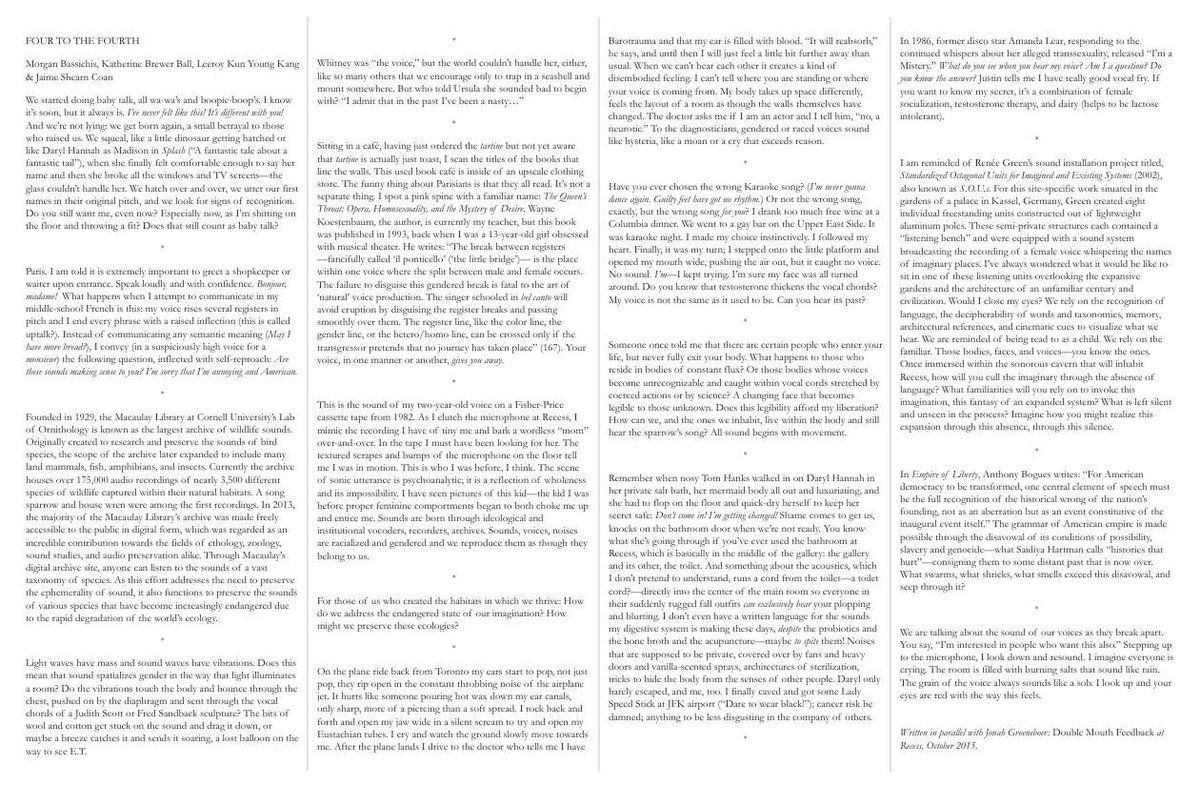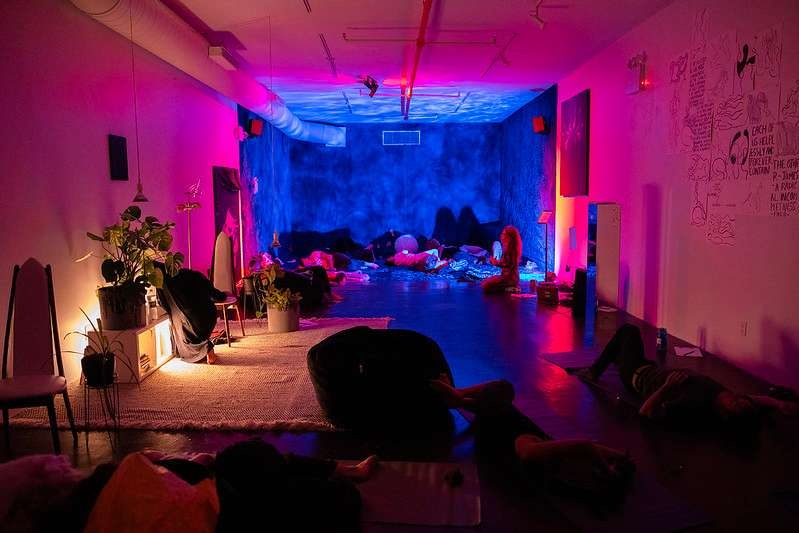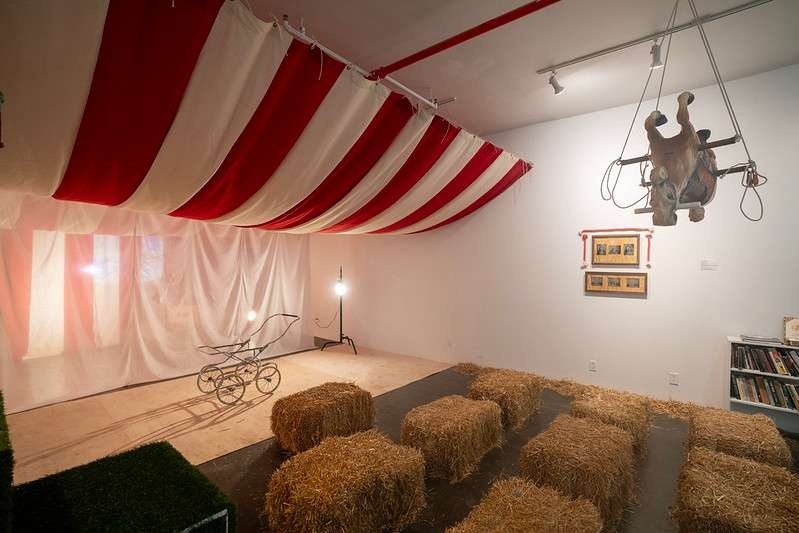Four to the Fourth
Morgan Bassichis, Jaime Shearn Coan, Katherine Brewer Ball, and Leeroy Kun Young Kang
We started doing baby talk, all wa-wa’s and boopie-boop’s. I know it’s soon, but it always is. I’ve never felt like this! It’s different with you! And we’re not lying: we get born again, a small betrayal to those who raised us. We squeal, like a little dinosaur getting hatched or like Daryl Hannah as Madison in Splash (“A fantastic tale about a fantastic tail”), when she finally felt comfortable enough to say her name and then she broke all the windows and TV screens—the glass couldn’t handle her. We hatch over and over, we utter our first names in their original pitch, and we look for signs of recognition. Do you still want me, even now? Especially now, as I’m shitting on the floor and throwing a fit? Does that still count as baby talk?
*
Paris. I am told it is extremely important to greet a shopkeeper or waiter upon entrance. Speak loudly and with confidence. Bonjour, madame! What happens when I attempt to communicate in my middle-school French is this: my voice rises several registers in pitch and I end every phrase with a raised inflection (this is called uptalk?). Instead of communicating any semantic meaning (May I have more bread?), I convey (in a suspiciously high voice for a monsieur) the following question, inflected with self-reproach: Are these sounds making sense to you? I’m sorry that I’m annoying and American.
*
Founded in 1929, the Macaulay Library at Cornell University’s Lab of Ornithology is known as the largest archive of wildlife sounds. Originally created to research and preserve the sounds of bird species, the scope of the archive later expanded to include many land mammals, fish, amphibians, and insects. Currently the archive houses over 175,000 audio recordings of nearly 3,500 different species of wildlife captured within their natural habitats. A song sparrow and house wren were among the first recordings. In 2013, the majority of the Macaulay Library’s archive was made freely accessible to the public in digital form, which was regarded as an incredible contribution towards the fields of ethology, zoology, sound studies, and audio preservation alike. Through Macaulay’s digital archive site, anyone can listen to the sounds of a vast taxonomy of species. As this effort addresses the need to preserve the ephemerality of sound, it also functions to preserve the sounds of various species that have become increasingly endangered due to the rapid degradation of the world’s ecology.
*
Light waves have mass and sound waves have vibrations. Does this mean that sound spatializes gender in the way that light illuminates a room? Do the vibrations touch the body and bounce through the chest, pushed on by the diaphragm and sent through the vocal chords of a Judith Scott or Fred Sandback sculpture? The bits of wool and cotton get stuck on the sound and drag it down, or maybe a breeze catches it and sends it soaring, a lost balloon on the way to see E.T.
*
Whitney was “the voice,” but the world couldn’t handle her, either, like so many others that we encourage only to trap in a seashell and mount somewhere. But who told Ursula she sounded bad to begin with? “I admit that in the past I’ve been a nasty…”
*
Sitting in a café, having just ordered the tartine but not yet aware that tartine is actually just toast, I scan the titles of the books that line the walls. This used book café is inside of an upscale clothing store. The funny thing about Parisians is that they all read. It’s not a separate thing. I spot a pink spine with a familiar name: The Queen’s Throat: Opera, Homosexuality, and the Mystery of Desire. Wayne Koestenbaum, the author, is currently my teacher, but this book was published in 1993, back when I was a 13-year-old girl obsessed with musical theater. He writes: “The break between registers—fancifully called ‘il ponticello’ (‘the little bridge’)—is the place within one voice where the split between male and female occurs. The failure to disguise this gendered break is fatal to the art of ‘natural’ voice production. The singer schooled in bel canto will avoid eruption by disguising the register breaks and passing smoothly over them. The register line, like the color line, the gender line, or the hetero/homo line, can be crossed only if the transgressor pretends that no journey has taken place” (167). Your voice, in one manner or another, gives you away.
*
This is the sound of my two-year-old voice on a Fisher-Price cassette tape from 1982. As I clutch the microphone at Recess, I mimic the recording I have of tiny me and bark a wordless “mom” over-and-over. In the tape I must have been looking for her. The textured scrapes and bumps of the microphone on the floor tell me I was in motion. This is who I was before, I think. The scene of sonic utterance is psychoanalytic; it is a reflection of wholeness and its impossibility. I have seen pictures of this kid—the kid I was before proper feminine comportments began to both choke me up and entice me. Sounds are born through ideological and institutional vocoders, recorders, archives. Sounds, voices, noises are racialized and gendered and we reproduce them as though they belong to us.
*
For those of us who created the habitats in which we thrive: How do we address the endangered state of our imagination? How might we preserve these ecologies?
*
On the plane ride back from Toronto my ears start to pop, not just pop, they rip open in the constant throbbing noise of the airplane jet. It hurts like someone pouring hot wax down my ear canals, only sharp, more of a piercing than a soft spread. I rock back and forth and open my jaw wide in a silent scream to try and open my Eustachian tubes. I cry and watch the ground slowly move towards me. After the plane lands I drive to the doctor who tells me I have Barotrauma and that my ear is filled with blood. “It will reabsorb,” he says, and until then I will just feel a little bit further away than usual. When we can’t hear each other it creates a kind of disembodied feeling. I can’t tell where you are standing or where your voice is coming from. My body takes up space differently, feels the layout of a room as though the walls themselves have changed. The doctor asks me if I am an actor and I tell him, “no, a neurotic.” To the diagnosticians, gendered or raced voices sound like hysteria, like a moan or a cry that exceeds reason.
*
Have you ever chosen the wrong Karaoke song? (I’m never gonna dance again. Guilty feet have got no rhythm.) Or not the wrong song, exactly, but the wrong song for you? I drank too much free wine at a Columbia dinner. We went to a gay bar on the Upper East Side. It was karaoke night. I made my choice instinctively. I followed my heart. Finally, it was my turn; I stepped onto the little platform and opened my mouth wide, pushing the air out, but it caught no voice. No sound. I’m—I kept trying. I’m sure my face was all turned around. Do you know that testosterone thickens the vocal chords? My voice is not the same as it used to be. Can you hear its past?
*
Someone once told me that there are certain people who enter your life, but never fully exit your body. What happens to those who reside in bodies of constant flux? Or those bodies whose voices become unrecognizable and caught within vocal cords stretched by coerced actions or by science? A changing face that becomes legible to those unknown. Does this legibility afford my liberation? How can we, and the ones we inhabit, live within the body and still hear the sparrow’s song? All sound begins with movement.
*
Remember when nosy Tom Hanks walked in on Daryl Hannah in her private salt bath, her mermaid body all out and luxuriating, and she had to flop on the floor and quick-dry herself to keep her secret safe: Don’t come in! I’m getting changed! Shame comes to get us, knocks on the bathroom door when we’re not ready. You know what she’s going through if you’ve ever used the bathroom at Recess, which is basically in the middle of the gallery: the gallery and its other, the toilet. And something about the acoustics, which I don’t pretend to understand, runs a cord from the toilet—a toilet cord?—directly into the center of the main room so everyone in their suddenly rugged fall outfits can exclusively hear your plopping and blurting. I don’t even have a written language for the sounds my digestive system is making these days, despite the probiotics and the bone broth and the acupuncture—maybe to spite them! Noises that are supposed to be private, covered over by fans and heavy doors and vanilla-scented sprays, architectures of sterilization, tricks to hide the body from the senses of other people. Daryl only barely escaped, and me, too. I finally caved and got some Lady Speed Stick at JFK airport (“Dare to wear black!”); cancer risk be damned; anything to be less disgusting in the company of others.
*
In 1986, former disco star Amanda Lear, responding to the continued whispers about her alleged transsexuality, released “I’m a Mistery.” What do you see when you hear my voice? Am I a question? Do you know the answer? Justin tells me I have really good vocal fry. If you want to know my secret, it’s a combination of female socialization, testosterone therapy, and dairy (helps to be lactose intolerant).
*
I am reminded of Renée Green’s sound installation project titled, Standardized Octagonal Units for Imagined and Existing Systems (2002), also known as S.O.U.s. For this site-specific work situated in the gardens of a palace in Kassel, Germany, Green created eight individual freestanding units constructed out of lightweight aluminum poles. These semi-private structures each contained a “listening bench” and were equipped with a sound system broadcasting the recording of a female voice whispering the names of imaginary places. I’ve always wondered what it would be like to sit in one of these listening units overlooking the expansive gardens and the architecture of an unfamiliar century and civilization. Would I close my eyes? We rely on the recognition of language, the decipherability of words and taxonomies, memory, architectural references, and cinematic cues to visualize what we hear. We are reminded of being read to as a child. We rely on the familiar. Those bodies, faces, and voices—you know the ones. Once immersed within the sonorous cavern that will inhabit Recess, how will you cull the imaginary through the absence of language? What familiarities will you rely on to invoke this imagination, this fantasy of an expanded system? What is left silent and unseen in the process? Imagine how you might realize this expansion through this absence, through this silence.
*
In Empire of Liberty, Anthony Bogues writes: “For American democracy to be transformed, one central element of speech must be the full recognition of the historical wrong of the nation’s founding, not as an aberration but as an event constitutive of the inaugural event itself.” The grammar of American empire is made possible through the disavowal of its conditions of possibility, slavery and genocide—what Saidiya Hartman calls “histories that hurt”—consigning them to some distant past that is now over. What swarms, what shrieks, what smells exceed this disavowal, and seep through it?
*
We are talking about the sound of our voices as they break apart. You say, “I’m interested in people who want this also.” Stepping up to the microphone, I look down and resound. I imagine everyone is crying. The room is filled with burning salts that sound like rain. The grain of the voice always sounds like a sob. I look up and your eyes are red with the way this feels.
About the artist
Morgan Bassichis
Morgan Bassichis is a writer and performer whose live comedic work explores history, mysticism, and just, like, being alive. Shows include When the Baba Yaga Eats You Alive and The Witch House. Morgan’s essays have appeared in the Radical History Review and other edited volumes.
Projects
Jaime Shearn Coan
Jaime Shearn Coan thinks and writes about contemporary performance, spectatorship, and queer archives. A doctoral student at The Graduate Center, CUNY, he is a regular contributor to the dance section of The Brooklyn Rail and the author of a poetry chapbook, Turn it Over (Argos Books, 2015).
Projects
Katherine Brewer Ball
Katherine Brewer Ball is a writer, scholar and curator who was born under an aries sun and libra moon. They are completing her first book on the aesthetic and political promise of escape, The Only Way Out is In: The Queer & Minoritarian Performance of Escape. As Visiting Assistant Professor of Performance Studies at Wesleyan University, she teaches courses on Queer Performance Strategies and Latina and Black Feminist Thought.
Projects
Leeroy Kun Young Kang
Leeroy Kun Young Kang is an archivist, visual artist, and curator whose work is rooted in the preservation and access of legacy audiovisual collections, experimental Asian Pacific film and video, and queer and transgender history and visual culture. Kang’s video work has screened both nationally and internationally and he has curated programs for the Los Angeles Asian Pacific Film Festival and Dirty Looks NYC. He holds a B.A. in Studio Art from UC Santa Barbara, an MLS from Queens College, and is currently a visiting scholar at the Asian/Pacific/American Institute at NYU.
Projects
Explore/Archive
See allDecember 2025
The INSTITUTE FOR TRANSHUMANIST CEPHALOPOD EVOLUTION and Learning from Octopuses
Barbara London
Barbara London reflect's of Miriam SImun's INSTITUTE FOR TRANSHUMANIST CEPHALOPOD EVOLUTION
October 2025
streamlined reflections, courtesy of noise canceling headphones
Gabrielle Rucker
Gabrielle Rucker reflects on the radical intimacy and auditory life at the heart of Deli Radio
July 2025
Tell My Jockey: CUNTRY’s Discourse From the Horse’s Mouth
Ericka Pérez
Assembly fellow Ericka Pérez reflects on clowning, resistance, and CUNTRY’s radical refusal to perform.







